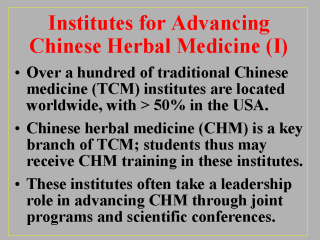| front |1 |2 |3 |4 |5 |6 |7 |8 |9 |10 |11 |12 |13 |14 |15 |16 |17 |18 |19 |20 |21 |22 |23 |review |
 |
Suffice to say,
the materials given in this lecture represent only the tip of the iceberg. And, again, the
lecturer here is not an expert in Chinese herbal medicine (CHM) or Chinese herbology by
any standard. The intent of this lecture is simply to utilize the quickest way to shed
some light to those students who do not have an understanding of this subject matter. For those students who are intrigued by this branch of health sciences, they may want to visit the numerous websites on this subject, or contact some of the Chinese medical institutes which each by definition should include a branch for CHM. These institutes often take a leadership role in advancing traditional Chinese medicine as well as CHM, such as through international conferences and joint programs with various research institutions that are forerunners in this field. There are over a hundred of such medical institutes located worldwide, with more than 50% located in the United States and Canada. The following are just a few of those located outside of the Asia continent: Rock Mountain Herbal Institute (Montana, USA); Pacific College of Oriental Medicine (San Diego, New York, Chicago, USA); The Academy of Clinical Chinese Medicine of Toronto (Canada); Belgian College of Traditional Chinese Medicine (Belgium); The South West College of Oriental Medicine (England); Institut Chuzhen de Médecine Chinoise (Paris, France); College of Traditional Chinese Medicine (Melbourne, Australia), etc. |